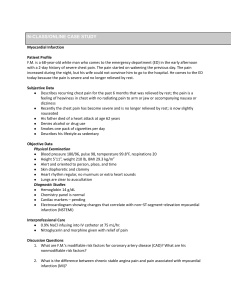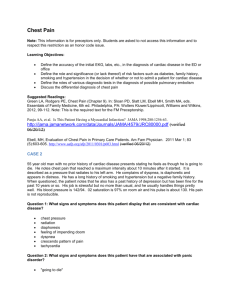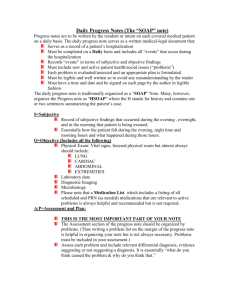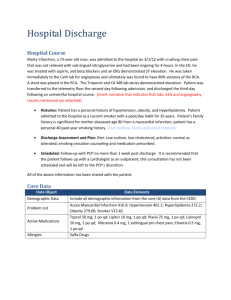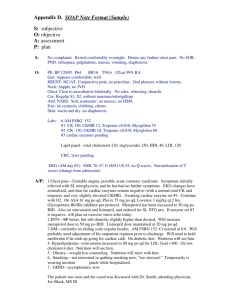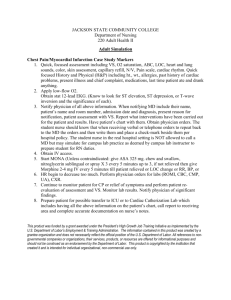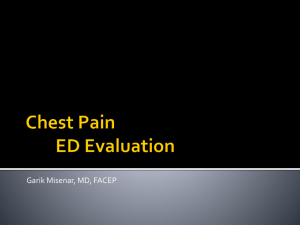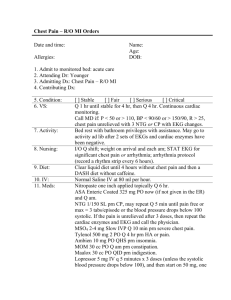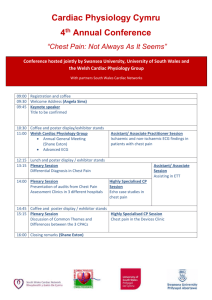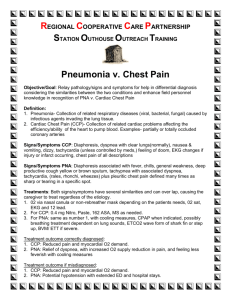Atypical MI Presentation: A Case Study & Women's Symptoms
advertisement
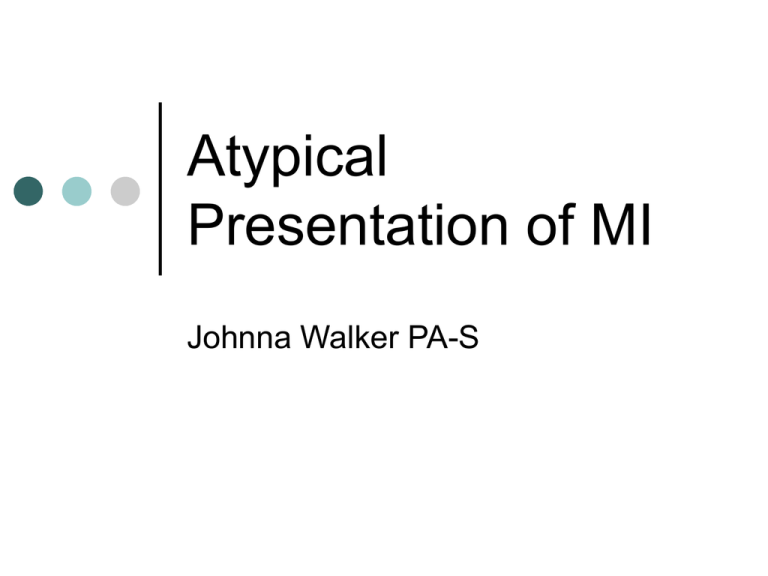
Atypical Presentation of MI Johnna Walker PA-S The case… 59 year old woman presents with chief complaint of persistent cough and chest congestion for 1 week. Treated at her family doc 5 days ago with Zithromax. Finished the Zithromax this morning but still not feeling well, and the cough is worse. She also complains of midsternal discomfort that has been lingering on for the past week, which she attributes to the force with which she is coughing. Risk Factors SH: ½ ppd smoker for 10 years. Quit approximately 6 months ago. PMH: HTN treated with 5 mg of Lisinopril. FH: No history of heart disease, MI, CAD, HTN, or CVA in family. Physical Exam Vitals: BP: 151/69, pulse: 67, Resp: 20, O2 Sats: 98% on room air. Appearance: In no apparent distress, not diaphoretic. Mild coughing fits during examination. Lungs: Diffuse wheezing and coarse rhonchi bilaterally. No rales heard. Heart: RRR without murmurs. Rest of the exam unremarkable. So it’s just a little bronchitis, right? We ordered a CBC with diff. Also, because the patient reported “discomfort” in her chest, likely from coughing so much, we performed a full cardiac workup. Chest X-Ray, EKG, Cardiac enzymes. Lab results CBC: WBC 9,500 (ref range 4,200-10,200) RBC 4,820,000 (4,200,000-5,400,000) Granulocytes, lymphocytes, monocytes, eosinophils all normal In other words, a completely normal CBC. Lab results Chest X- ray: EKG: Completely unremarkable Sinus rhythm with short PR status, left ventricular hypertrophy with repolorization abnormality status “an abnormal EKG which could not rule out inferior infarct” Lab results Troponin I- 5.89 ng/ml (ref range 0.000.49) Creatinine Kinase- 1,023 ng/ml (ref range 0-170) In other words: “crap” Quick, page cardiology! Cath report showed: Ejection Fraction: 45% LAD stenosis of 90% Proximal circumflex artery stenosis of 100% RCA stenosis of 90% Myocardial infarction (things we all know, but I needed additional slides) rapid development of heart muscle necrosis caused by an ischemic event, usually because of a plaque rupture with a clot formation in a coronary vessel, resulting in blockage of the blood supply to that area Typical symptoms: Chest pain that is described as being tight, pressure, or squeezing; that can radiate to the jaw, neck, or left arm. Other symptoms: dyspnea, anxiety, lightheadedness, diaphoresis. MI Labs/studies EKG ST segment elevation > 1 mm Presence of new Q waves Cardiac enzymes Troponin I• Greatest sensitivity and specificity for MI • Levels rise within 3-4 hours and remain elevated for 10 days Creatinine Kinase• CK-MB is cardiac specific • Levels rise within 3-4 hours, peaks within 12 hours, and returns to normal within 24-36 hours Myocardial infarction in women Research has shown that more men than women are affected with MIs, but recent research is showing this might be because women have more ‘atypical’ presentations of MI and are therefore mis-diagnosed. So, what is this ‘atypical’ presentation you speak of? Women are more likely to have a prodrome of symptoms in the month leading up to the MI. Unusual fatigue Sleep disturbances Shortness of breath Indigestion Anxiety Persistent cough Atypical presentation of acute MI in women Most frequent symptoms in women with an acute MI: Shortness of breath Weakness Fatigue Cold sweats Dizziness In fact, in a study of 515 women diagnosed with an acute MI, chest pain was absent in 43%!!!! McSweeney, J., Cody, M., & O’Sullivan, P. (2003). Women’s Early Warning Symptoms of Acute Myocardial Infarction. Circulation. 108 (21), 2619-23. What this means to us as providers… As a family practitioner, how many of us wouldn’t have done the same thing in this case? Sounds like bronchitis, write a prescription for an antibiotic, and move on. What would have happened if this woman hadn’t presented to an ED where we have the resources to do the appropriate labs and studies? We have to be careful not to miss presentations like this. Even without warning signs, appropriate risk factors, etc, we always have to… … think about the zebras! (come on, you know you’ve missed that!) Don’t we all…
